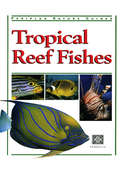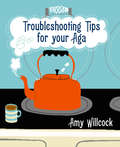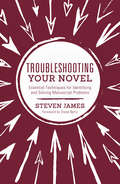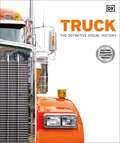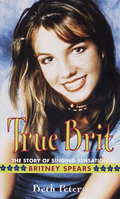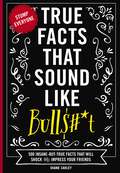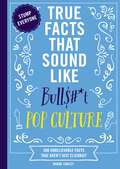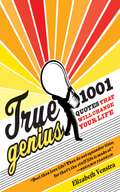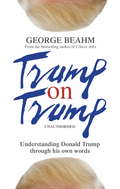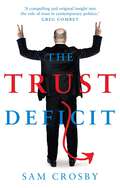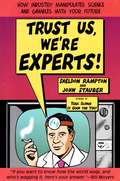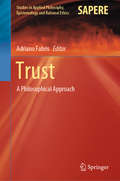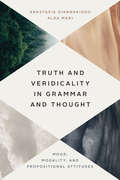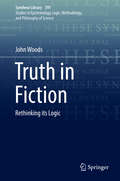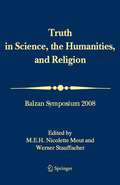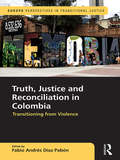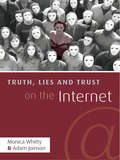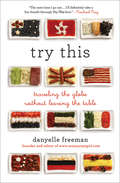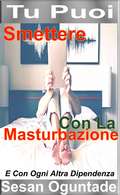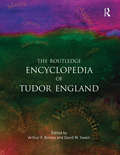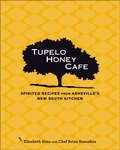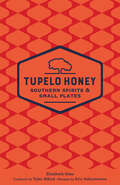- Table View
- List View
Tropical Reef Fishes
by Gerald AllenThis Periplus Nature Guide provides an excellent introduction to 68 of the most commonly encountered tropical reef fishes. Written by Dr. Gerald Allen, international authority on reef fishes, it features stunning color shots by some of the world's best underwater photographers.
Troubleshooting Tips for Your Aga
by Amy WillcockMore people than ever before are discovering the joys of the Aga. It's so much more than just a cooker - it's a style statement and a way of life. But Agas are notoriously tricky to master, and where do you turn to with those niggling questions like, what do you cook where, how do you control heat loss, and how do you bake the perfect cake? Now in Troubleshooting Tips for your Aga, renowned Aga cook and expert Amy Willcock brings you the answers to all these questions and many more. From advice on temperature and timings, to vital cooking equipment, to cleaninig and servicing, and even using your Aga for more than just cooking, this is the top tips book for every Aga owner.Amy also answers the most Frequently Asked Questions about Agas, with a general troubleshooting guide to cover every eventuality. You'll wonder how you managed without it!
Troubleshooting Your Novel: Essential Techniques for Identifying and Solving Manuscript Problems
by Steve Berry Steven JamesTake your story to the next level of excellence! You've completed the first draft of your novel--now what? Chances are, it's not perfect...at least not yet. In order to increase your chances of getting a literary agent, selling your manuscript to a publisher, or garnering an audience for your self-published work, you need targeted, practical instruction on tackling the problem areas and weak spots in your story. You need Troubleshooting Your Novel. In this hand-on, easy-to-use guide, award-winning author Steven James provides helpful techniques and checklists, timesaving tricks of the trade, and hundreds of questions for manuscript analysis and revision. You'll learn how to:ADJUST elements of story progression, from causality, tension, and setbacks to plot twists, climaxes, and endings.DEVELOP authentic, riveting characters by exploring their attitudes, desires, beliefs, and more.LEARN narrative techniques for elements such as dialogue, flashbacks, suspense, voice, subtext, and flow.ENSURE reader engagement by aligning with their expectations, fulfilling promises, and instilling trust.CHECK issues with context and continuity.You owe your book more than just a polish and a proofread. Strengthen your story, prepare it for the marketplace, and make it the best it can be with Troubleshooting Your Novel.
Trout and Salmon of North America
by Thomas Mcguane Joe Tomelleri Robert BehnkeThis beautiful and definitive guide brings together the world's lead leading expert on North American trout and salmon, Robert Behnke, and the foremost illustrator in the field, Joseph Tomelleri. North America is graced with the greatest diversity of trout and salmon on earth. From tiny brook trout in mountain streams of the Northeast, to cutthroat trout in the rivers of the Rockies, to Chinook salmon of the Pacific, the continent is home to more than 70 types of trout and salmon. How this came to be, how they are related, and what makes them unique -- and so breathtaking -- is the story of Trout and Salmon of North America. The more than 100 illustrations of trout and salmon by Joseph Tomelleri showcased here exhibit a genius for detail, coloration, and proportion. Each portrait is made from field notes, streamside observations, photographs, and specimens collected by the artist. The result is a set of the most accurate and stunning illustrations of fish ever created. Robert Behnke has distilled 50 years of his research and writing about trout and salmon in completing this book. No one understands better than Behnke the diversity and conservation issues concerning these fishes or communicates so lucidly the biological wonders and complexities of their particular beauty. Also included are more than 40 richly detailed maps that clearly show the ranges of populations of trout and salmon throughout North America. An irresistible delight for anyone who appreciates natural history, Trout and Salmon of North America is a master guide to the natural elegance of our native fishes.
Truck: The Definitive Visual History (DK Definitive Visual Histories)
by DKA lavishly illustrated celebration of trucks and trucking, from the first motorized wagons to the advent of electric, driverless freight vehicles.Charting decade after decade of innovation and change, The Truck Book is a beautifully illustrated history of trucks, trucking culture, and the romance of the open road.Trucks, semis, and vans share their origins in the steam wagons of the 1800s and the invention of the modern combustion engine in the 1870s. As steam power gave way to gas and diesel engines, trucks evolved and diversified according to their desired purpose - becoming everything from panel vans and pickup trucks to heavy goods vehicles (HGVs), or construction trucks, such as log carriers or concrete transporters. Military forces worldwide soon realized the value in these vehicles, and so they played a defining role in the wars of the 20th century. In the meantime, they have also saved lives as ambulances and fire trucks and entertained the masses in the form of monster trucks. The Truck Book showcases the most important and iconic makes and models of every era - from the Ford TT to the Bedford TM Turbo 92 Series, to the Toyota Hilux. Along the way, it evokes the freedom and nostalgia of the open road, explores trucking culture, and shows how trucks and trucking companies, such as Mack and UPS, have won a place in fans' hearts. Weaving together stunning photographic catalogs with specially commissioned "visual tours," feature spreads on truck models, designers, and manufacturers, as well as on milestone events or technological developments over the last 200 years, The Truck Book is the most comprehensive and best-illustrated title available on the subject.
True Brit
by Beth PetersPOP PRINCESS Britney Spears is putting girls back on the map in the pop music world. With the effervescent and intoxicating sounds of her first album, . . . Baby One More Time, Britney shot straight to the top of the charts--in just the first week of the album's release. Her ripe style and smart lyrics have captured the hearts of millions of fans, young and old. But Britney didn't just come out of nowhere: she is a multitalented entertainment sensation who can't remember a time in her life when she wasn't singing, acting, or dancing. She broke into the biz at the tender age of eight, and it wasn't long before she made her mark. TRUE BRIT gives you all the backstage info, from her first audition for The New Mickey Mouse Club to her exciting decision to go solo. You'll also find out what it was like for Brit to work with the boys of 'N Sync, the rumors of romance, and her dazzling life beyond the stage. Britney is more than just a singer--she's a performing phenomenon. And TRUE BRIT is your ticket into her amazing world.
True Facts That Sound Like Bull$#*t: 500 Insane-But-True Facts That Will Shock and Impress Your Friends (Mind-Blowing True Facts)
by Shane CarleyProve you are the smartest schmuck in the room with 500 true trivia facts that sound absurd. These facts are so absurd some might even say that they sound like bull$#*t!Knowledge is power! Crush the competition at trivia night, or start the most interesting conversation ever with real facts that are hard to believe. This book is loaded with mind-blowing facts that are sure to keep you wondering, "How are these even true?" while equipping you to outsmart everyone around and blow their minds. Topics include:ScienceAmerican SportsHistoryPop CultureNaturePut your game face on, and prove once and for all that you are the real know-it-all! Gather your friends and family 'round and get ready to learn some wild and crazy trivia and facts such as:True or False? A chicken once survived almost two years after having its head cut off.True or False? The dog that played Toto in The Wizard of Oz was paid a salary.How many baseballs does the MLB use every season?What state has jousting as its official sport?True or False? Most Canadians live south of Seattle.Stump everyone with True Facts That Sound Like Bull$#*t!
True Facts That Sound Like Bull$#*t: 500 Unbelievable Facts That Aren’t Just Clickbait
by Shane CarleyProve you are the most cultured person in the room with 500 true trivia facts about pop culture. These facts are so absurd some might even say that they sound like bull$#*t! Explore the scandalous and the secretive in this all access addition to the True Facts series that spills all the gossip of your favorite celebrities, movies, music, and more. Give the gift that keeps giving to friends, family, fathers, or grads and test your knowledgeKnowledge is power! Crush the competition at trivia night or start the most interesting conversation ever with real facts that are hard to believe. This astonishing collection of facts is so wild and unexpected, it seems like pure fiction. True Facts That Sound Like Bull$#*t: Pop Culture is your all-access pass to uncovering the craziest stories, facts, and trivia about your favorite celebrities, movies, music, and more. From the unthinkable behind-the-scenes tales of Hollywood to the most surprising celebrity quirks, this compendium dives deep into the heart of pop culture&’s most bewildering mysteries and phenomena. Whether you&’re a pop culture aficionado, a trivia enthusiast, or simply in search of a good laugh, this book is an essential addition to your collection.Inside you&’ll discover facts such as:The iconic scream of the TIE fighters in Star Wars was actually made by combining an elephant's call with car tire screeches on wet pavement.Before hitting it big, Elvis Presley was a truck driver, and Jim Carrey once worked as a janitor.The famous "I'll be back" line from The Terminator was almost "I will return."Michael Jackson attempted to buy Marvel Comics in the 1990s because he wanted to play Spider-Man in his own produced movie.The first YouTube video was uploaded by co-founder Jawed Karim, featuring him at the San Diego Zoo and titled "Me at the zoo."Strap in for an exhilarating ride through the wildest, most peculiar, and unbelievably true corners of pop culture. Your view of the entertainment world will never be the same!
True Genius: 1001 Quotes That Will Change Your Life
by Elizabeth VenstraThe earliest form of the word "genius" referred to a person who powerfully influenced the character, conduct, or fortunes of another. Times have changed and with them the various connotations of the word "genius," but today we still look to the more enlightened members of our society to elevate the rest of us. True Genius is a compendium of 1,001 moving quotes from the world's geniuses of the past and present whose words will leave an indelible mark on your life. Selected from the output of the greatest minds in literature, history, philosophy, philanthropy, and art-and divided into categories such as love, life, and forgiveness-these words of wisdom are sure to inspire the positive change and mental improvement necessary for your own quest to achieve true genius.
True Ladies and Proper Gentlemen: Victorian Etiquette for Modern-Day Mothers and Fathers, Husbands and Wives, Boys and Girls, Teachers and Students, and More
by Sarah A. ChrismanRegardless of time period, some things hold true: kindness is timeless. Invasion of privacy; divorce; relationship issues; encounters between people from different places and cultures; new technologies developed at dizzying speeds . . . the hectic pace of life in the late nineteenth century could make the mind reel. Wait a minute--the nineteenth century? Many of the issues people faced in the 1880s and ’90s surprisingly remain problems in today’s modern world, so why not take a peek at some Victorian advice about negotiating life’s dizzying twists and turns? Gathered from period magazines and Hill’s Manual of Social and Business Forms, a book on social conduct originally published in 1891, this volume provides timeless guidance for a myriad of situations, including: The husband’s duty: Give your wife every advantage that it is possible to bestow. Suggestions about shopping: Purchasers should, as far as possible, patronize the merchants of their own town. (Buy local!) Suggestions for travel: Having paid for one ticket, you are entitled to only one seat. It shows selfishness to deposit a large amount of baggage in the surrounding seats and occupy three or four. Unclassified laws of etiquette: Never leave home with unkind words. This advice is accompanied by watercolors and illustrations throughout. Though these are tips originate from nineteenth-century ideas, you’ll find that they certainly do still apply.
Trump on Trump
by George BeahmOne thing you cannot deny about Donald Trump is that he speaks his mind... and the results are fascinating!Get to know how that mind works by reading his words. This is an unbiased collection of Trump's most famous and interesting quotes and thus an unofficial guide to his thinking.Brash, outspoken and successful, Donald Trump is a political phenomenon. Some of his more contentious comments have outraged the immigrant community, feminist groups and even the Pope. Whether you like him or loathe him, he's impossible to ignore.Now you can understand more about this most infamous public figure and form your own opinion about the way he thinks. Covering the time since Trump announced that he was running for Republican candidacy, this book looks at excerpts and speeches and puts them into context. Among many topics it covers his views on business, America and other countries; his opinion of himself, women and those who stand, or have stood, against him.This is a fascinating insight into the world's most controversial politician.
Trust Deficit
by Sam CrosbyTrust is the most powerful weapon in the political arsenal. It can pierce an opponent's armour or deflect the most ferocious attack. It can explain difficult policies, and become a well of goodwill that politicians can draw from in their darkest hours. Yet despite its great value we are resigned to the idea that trust in politics will continue to decline.Drawing on contemporary political stories and examples, The Trust Deficit shows us how faith in our politicians has been eroded but how it can be rebuilt.Julia Gillard's pledge that there wouldn't be a carbon tax and Tony Abbott's promise of no cuts to health or education saw a collapse in their governments' levels of support.By breaking trust down to its elements—reliability and competence, openness and honesty—we see how recent leaders established trust and used it to their political advantage.
Trust Us, We're Experts
by Sheldon Rampton John StauberFearless investigative journalists Sheldon Rampton and John Stauber ( Toxic Sludge Is Good for You! and Mad Cow U.S.A.) are back with a gripping expos of the public relations industry and the scientists who back their business-funded, anti-consumer-safety agendas. There are two kinds of "experts" in question--the PR spin doctors behind the scenes and the "independent" experts paraded before the public, scientists who have been hand-selected, cultivated, and paid handsomely to promote the views of corporations involved in controversial actions. Lively writing on controversial topics such as dioxin, bovine growth hormone, and genetically modified food makes this a real page-turner, shocking in its portrayal of the real and potential dangers in each of these technological innovations and of the "media pseudo-environment" created to obfuscate the risks. By financing and publicizing views that support the goals of corporate sponsors, PR campaigns have, over the course of the century, managed to suppress the dangers of lead poisoning for decades, silence the scientist who discovered that rats fed on genetically modified corn had significant organ abnormalities, squelch television and newspaper stories about the risks of bovine growth hormone, and place enough confusion and doubt in the public's mind about global warming to suppress any mobilization for action. Rampton and Stauber introduce the movers and shakers of the PR industry, from the "risk communicators" (whose job is to downplay all risks) and "outrage managers" (with their four strategies--deflect, defer, dismiss, or defeat) to those who specialize in "public policy intelligence" (spying on opponents). Evidently, these elaborate PR campaigns are created for our own good. According to public relations philosophers, the public reacts emotionally to topics related to health and safety and is incapable of holding rational discourse. Needless to say, Rampton and Stauber find these views rather antidemocratic and intend to pull back the curtain to reveal the real wizard in Oz. This is one wake-up call that's hard to resist.
Trust: A Philosophical Approach (Studies in Applied Philosophy, Epistemology and Rational Ethics #54)
by Adriano FabrisThis book presents cutting-edge concepts on the question of trust. Written by leading experts, it investigates a paradoxical feature of contemporary society: while information and communication technologies, on the one hand, and scientific discourses, on the other, can promote more informed participation in public and democratic life, they have also led to a dramatic decline in our communicative and cooperative skills. The book analyzes the notion of trust from an interdisciplinary perspective by combining the normative (continental) and empirical (Anglo-American) approaches and by considering the political, epistemological, and historical transformations in the interpersonal relationships sparked by new technologies. Using trust as a model, it then investigates and clarifies the new types of participation that are made possible by scientific and technological advances.
Truth and Veridicality in Grammar and Thought: Mood, Modality, and Propositional Attitudes
by Anastasia Giannakidou Alda Mari PhDCan language directly access what is true, or is the truth judgment affected by the subjective, perhaps even solipsistic, constructs of reality built by the speakers of that language? The construction of such subjective representations is known as veridicality, and in this book Anastasia Giannakidou and Alda Mari deftly address the interaction between truth and veridicality in the grammatical phenomena of mood choice: the indicative and subjunctive choice in the complements of modal expressions and propositional attitude verbs.Combining several strands of analysis—formal linguistic semantics, syntactic theory, modal logic, and philosophy of language—Giannakidou and Mari’s theory not only enriches the analysis of linguistic modality, but also offers a unified perspective of modals and propositional attitudes. Their synthesis covers mood, modality, and attitude verbs in Greek and Romance languages, while also offering broader applications for languages lacking systematic mood distinction, such as English. Truth and Veridicality in Grammar and Thought promises to shape longstanding conversations in formal semantics, pragmatics, and philosophy of language, among other areas of linguistics.
Truth in Fiction: Rethinking Its Logic (Synthese Library #391)
by John WoodsThis monograph examines truth in fiction by applying the techniques of a naturalized logic of human cognitive practices. The author structures his project around two focal questions. What would it take to write a book about truth in literary discourse with reasonable promise of getting it right? What would it take to write a book about truth in fiction as true to the facts of lived literary experience as objectivity allows?It is argued that the most semantically distinctive feature of the sentences of fiction is that they areunambiguously true and false together. It is true that Sherlock Holmes lived at 221B Baker Street and also concurrently false that he did. A second distinctive feature of fiction is that the reader at large knows of this inconsistency and isn’t in the least cognitively molested by it. Why, it is asked, would this be so? What would explain it?Two answers are developed. According to the no-contradiction thesis, the semantically tangled sentences of fiction are indeed logically inconsistent but not logically contradictory. According to the no-bother thesis, if the inconsistencies of fiction were contradictory, a properly contrived logic for the rational management of inconsistency would explain why readers at large are not thrown off cognitive stride by their embrace of those contradictions. As developed here, the account of fiction suggests the presence of an underlying three - or four-valued dialethic logic. The author shows this to be a mistaken impression. There are only two truth-values in his logic of fiction.The naturalized logic of Truth in Fiction jettisons some of the standard assumptions and analytical tools of contemporary philosophy, chiefly because the neurotypical linguistic and cognitive behaviour of humanity at large is at variance with them. Using the resources of a causal response epistemology in tandem with the naturalized logic, the theory produced here is data-driven, empirically sensitive, and open to a circumspect collaboration with the empirical sciences of language and cognition.
Truth in Science, the Humanities and Religion
by International Balzan FoundationThe question of the meaning of "truth" is central to many areas of contemporary debate, whether between those subscribing to a post-Enlightenment view of the world and those who seek fundamental truth in religious texts, or between those maintaining that there are absolute truths and those believing facts to be social constructs. For some, the ultimate truth is revealed through religious faith and textual authority. Can this view be reconciled with an evidence-based, materialist, post-Enlightenment perspective of the truth as embraced by the natural sciences? If religion holds the key to the truth, which religion and which truths? What is the attitude of the humanities to the meaning of truth? Truth in the sciences and the humanities as well as in religion and theology is the central theme of this book based on the proceedings of a conference organized by the International Balzan Foundation. It contains the speakers' lectures, the corresponding reactions of the invited panel members as well as the general discussions. The reader can familiarize himself with views ranging from philosophy to religion, from mathematics, physics and cosmology to biological sciences, history, sociology and economics. The exceptional wide scope of the book, comprising arguments about truth in the sciences, the humanities as well as religion and theology together with the discussions between representatives of all these different fields, means that it is of interest to a professional as well as a general readership.
Truth, Justice and Reconciliation in Colombia: Transitioning from Violence (Europa Perspectives in Transitional Justice)
by Fabio Andres Diaz PabonThe signing of the peace agreements between the FARC-EP and the Colombian Government in late November 2016 has generated new prospects for peace in Colombia, opening the possibility of redressing the harm inflicted on Colombians by Colombians. Talking about peace and transitional justice requires us to think about how to operationalize peace agreements to promote justice and coexistence for peace. This volume brings together reflections by Colombian academics and practitioners alongside pieces provided by researchers and practitioners in other countries where transitional justice initiatives have taken place (Bosnia and Herzegovina, South Africa, Sri Lanka and Peru). This volume has been written in the south, by the south, for the south. The book engages with the challenges ahead for the coming generations of Colombians. Rivers of ink have dealt with the end goals of transitional justice, but victims require us to take the quest for human rights beyond the normative realm of theorizing justice and into the practical realm of engaging how to implement justice initiatives. The tension between theory—the legislative frameworks guaranteeing human rights—and practice—the realization of these ideas—will frame Colombia’s success (or failure) in consolidating the implementation of the peace agreements with the FARC-EP.
Truth, Lies and Trust on the Internet
by Monica T. Whitty Adam JoinsonThe Internet is often presented as an unsafe or untrustworthy space: where children are preyed upon by paedophiles, cannibals seek out victims, offline relationships are torn apart by online affairs and where individuals are addicted to gambling, love, and cybersex. While many of these stories are grounded in truth, they do paint a rather sensationalized view of the Internet, the types of people who use it, and the interactions that take place online. Simultaneously, researchers claim that the Internet allows individuals to express their true selves, to develop 'hyperpersonal' relationships characterised by high levels of intimacy and closeness. At the heart of these competing visions of the Internet as a social space are the issues of truth, lies and trust. This book offers a balanced view of the Internet by presenting empirical data conducted by social scientists, with a concentrated focus on psychological studies. It argues that the Internet’s anonymity which can enable, for instance, high levels of self-disclosure in a relationship, is also responsible for many of its more negative outcomes such as deception and flaming. This is the first book to develop a coherent model of the truth-lies paradox, with specific reference to the critical role of trust. Truth, Lies and Trust on the Internet is a useful text for psychology students and academics interested in Internet behaviour, technology, and online deviant behaviour, and related courses in sociology, media studies and information studies.
Try This
by Danyelle FreemanWitty and charming, Try This is an adventurous and accessible guide to eating out in the twenty-first century, perfect for anyone who loves food but wants to break out of a restaurant rut. From banh mi to bocadillos, spotted dick to soup dumplings, meze to ma po tofu, Try This travels the culinary map as it demystifies unfamiliar foods in sparkling prose that will leave your stomach growling. From newbie foodies to experienced eaters, there's something in Try This for everyone to discover. In the Restaurant Girl's own words, "I'm writing this book for anyone who's ever looked at a menu and had a question. Anyone who's had a plate put in front of him and wondered what the hell was in it?" Convivial and encouraging, Try This reminds us that eating out is a delicious adventure: "Life is one long feast. Devour it."
Tu Puoi Smettere Con La Masturbazione: E Con Ogni Altra Dipendenza
by Sesan OguntadeStai lottando per fermare la masturbazione e ogni forma di dipendenza? Vuoi davvero una guida cristiana completa che usi storie semplici e grafici semplici per descrivere i metodi passo dopo passo per porre fine alla masturbazione o qualsiasi problema di dipendenza? Questo pratico libro cristiano sarà di grande utilità per te come lo è stato per molti altri online. A causa delle reazioni positive dei lettori alle strategie di story-telling e chart-illustration utilizzate nella prima edizione di questo libro per fornire semplici passaggi per risolvere il problema della masturbazione, l'autore, Sesan Oguntade ha prodotto un'edizione più grande che contiene diverse reazioni dei lettori, più illustrazioni di grafici, 13 note cristiane per genitori sulla risoluzione di problemi di dipendenza da adolescenti. I cristiani e chiunque desideri veramente interrompere la masturbazione o qualsiasi problema di dipendenza non dovrebbero perdere l'opportunità di scaricare questo libro immediatamente
Tudor England: An Encyclopedia
by Arthur F. Kinney David W. Swain Eugene D. Hill William B. Long Francisco J. Borge R. Morgan GriffinThis is the first encyclopedia to be devoted entirely to Tudor England. 700 entries by top scholars in every major field combine new modes of archival research with a detailed Tudor chronology and appendix of biographical essays.Entries include: * Edward Alleyn [actor/theatre manager] * Roger Ascham * Bible translation * cloth trade * Devereux fami
Tupelo Honey Cafe: Spirited Recipes from Asheville's New South Kitchen (Tupelo Honey Cafe #1)
by Elizabeth Sims Chef Brian Sonoskus“Tupelo Honey Café offers not only offers tastes from its distinctive kitchen, but the full, delicious flavor of Asheville’s fresh, artisanal, food scene.” (Ronni Lundy, author of Shuck Beans, Stack Cakes and Honest Fried Chicken and Butter Beans to Blackberries)Experiencing the food at the award-winning Tupelo Honey Cafe is an important part to understanding the heart of Asheville, NC. As an early pioneer in the farm-to-fork movement, chef Brian Sonoskus has been creating delicious dishes at the Tupelo Honey Cafe in downtown Asheville, North Carolina, since it first opened in 2000. And from then on, Tupelo's food has been consistently fresh, made from scratch, sassy, and scrumptious.Heralding in its own unique style of cuisine representative of the New South, the Tupelo Honey Cafe salutes the love of Southern traditions at the table, but like the people of Asheville, marches to its own drum. The result is a cookbook collection of more than 125 innovative riffs on Southern favorites, illustrated with four-color photographs of the food, restaurant, locals, farmers' markets, and farms, in addition to black-and-white archival photography of Asheville. At Tupelo, grits become Goat Cheese Grits, fried chicken becomes Nutty Fried Chicken with Mashed Sweet Potatoes, and poached eggs become Eggs with Homemade Crab Cakes and Lemon Hollandaise Sauce.Capturing the independent and creative spirit of Asheville, Tupelo has garnered praise from the New York Times, Southern Living, and the Food Network, just to name a few.“Tupelo Honey Café’s recipes will appeal to the home cook because they’re oh-so-approachable. How many restaurant cookbooks can make that claim? Precious few!” –Jean Anderson, A Love Affair with Southern Cooking
Tupelo Honey Southern Spirits & Small Plates (Tupelo Honey Cafe #3)
by Elizabeth Sims Tyler AlfordA recipe collection celebrating the culinary traditions of the American South, featuring appetizers and beverages from the menu of Tupelo Honey restaurant.The South loves to drink; this is no revelation. But understanding the rich traditions behind why southerners drink, what they drink, and when they drink is critical to learning the art and fashion of southern imbibing. They certainly know their spirits, artisanal distilleries, and prolific craft breweries, and at Tupelo Honey Cafe and Tupelo Honey Southern Kitchen & Bar’s fifteen locations, the staff is committed to sourcing the best ingredients to make some of the tastiest cocktails and small plates south of the Mason Dixon Line.In Tupelo Honey’s latest cookbook, seventy unique cocktail and thirty delicious small plate recipes are organized around popular themes, such as Friendly Competition, The Roots of Southern Music, Southern Festivals, Southern Drinking Celebrations, Iconic Southern Food and Drink, and Simple, Everyday Life. Some of the playful cocktail names in this book may give you pause, but once you try them, your taste buds will smile.Among the made-from-scratch cocktails and small plates perfect for two or twenty are Violet Beaureguard, Tar Heel Gin Fiz, Rubbin' is Racin' Peach Moonshine-Sweet Tea, Johnny Cakes with BBQ Pulled Pork and Corn-Jalapeño Slaw, Goat Cheese Deviled Eggs with Country Ham Prosciutto, and Don't Judge My Okra Obsession.
Tupelo Honey Southern Spirits & Small Plates (Tupelo Honey Cafe)
by Elizabeth Sims Tyler AlfordA recipe collection celebrating the culinary traditions of the American South, featuring appetizers and beverages from the menu of Tupelo Honey restaurant.The South loves to drink; this is no revelation. But understanding the rich traditions behind why southerners drink, what they drink, and when they drink is critical to learning the art and fashion of southern imbibing. They certainly know their spirits, artisanal distilleries, and prolific craft breweries, and at Tupelo Honey Cafe and Tupelo Honey Southern Kitchen & Bar’s fifteen locations, the staff is committed to sourcing the best ingredients to make some of the tastiest cocktails and small plates south of the Mason Dixon Line.In Tupelo Honey’s latest cookbook, seventy unique cocktail and thirty delicious small plate recipes are organized around popular themes, such as Friendly Competition, The Roots of Southern Music, Southern Festivals, Southern Drinking Celebrations, Iconic Southern Food and Drink, and Simple, Everyday Life. Some of the playful cocktail names in this book may give you pause, but once you try them, your taste buds will smile.Among the made-from-scratch cocktails and small plates perfect for two or twenty are Violet Beaureguard, Tar Heel Gin Fiz, Rubbin' is Racin' Peach Moonshine-Sweet Tea, Johnny Cakes with BBQ Pulled Pork and Corn-Jalapeño Slaw, Goat Cheese Deviled Eggs with Country Ham Prosciutto, and Don't Judge My Okra Obsession.
